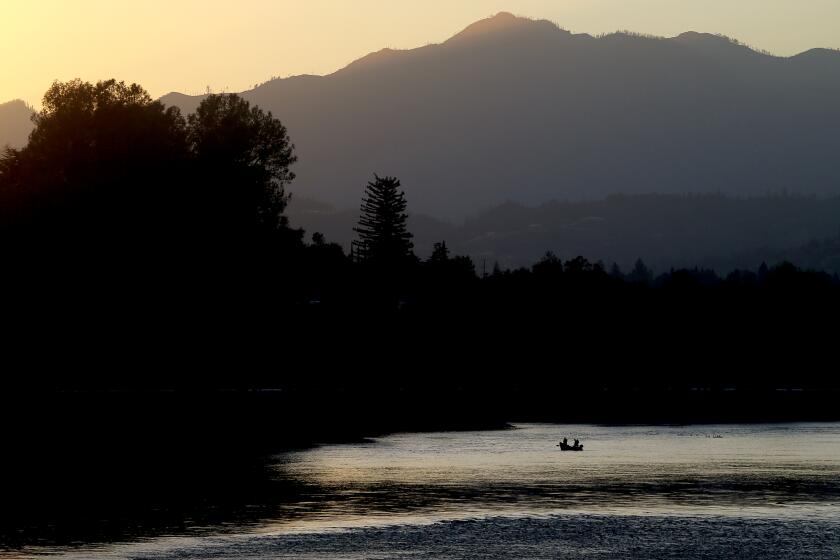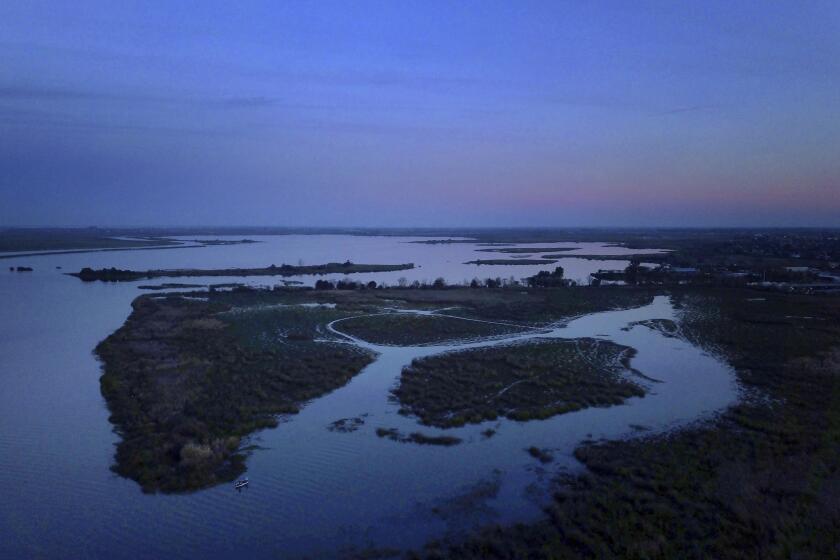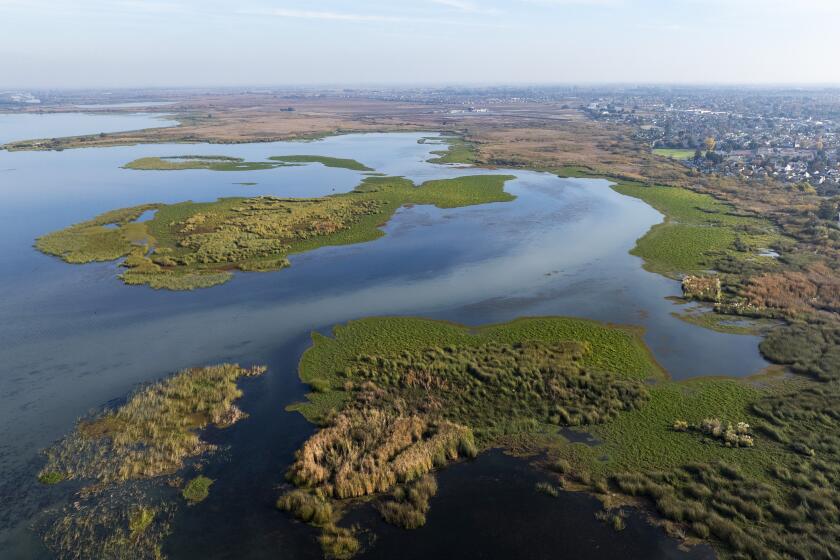
- Share via
Powerful pumps that supply much of California’s population with water have killed several thousand threatened and endangered fish this year, prompting a coalition of environmental groups to demand that state and federal agencies take immediate steps to limit “alarming levels” of deaths.
In a letter to state and federal water managers, leaders of five fishing and environmental groups said the estimated losses of threatened steelhead trout and endangered winter-run Chinook salmon have exceeded maximum annual limits for water intakes in the Sacramento-San Joaquin River Delta.
“Given that these and other species in the Bay-Delta are at grave risk of extinction, we want to emphasize the need for urgent action,” the environmental advocates wrote.
Aggressive and impactful reporting on climate change, the environment, health and science.
The massive pumps that draw water into the aqueducts of the State Water Project and the Central Valley Project are strong enough to reverse the flow in parts of the south delta. They can also suck fish into their machinery or make them easy prey for predators. Because of this, pumping facilities are assigned annual take limits for certain fish under the Endangered Species Act.
The environmental groups are urging water managers to scale back pumping until juvenile salmon and steelhead have finished migrating through the delta and into San Francisco Bay.
“To see the state and federal water agencies exceed their take limits and continue business-as-usual water exports is like witnessing extinction in real time,” said Jon Rosenfield, science director of San Francisco Baykeeper. “It demonstrates the official negligence and lawlessness that caused these fish, and many others, to become endangered in the first place.”
State water officials say they have been taking substantial measures to protect fish. They say the large numbers of fish that have moved into areas around the water intakes have caused them to pump less than they typically would based on current conditions.
The losses are calculated based on the numbers of fish that are collected — scooped from the water in a bucket-like device at the state facility — then transported by truck and released into the delta nearby. The calculations attempt to account for fish that are caught by predators and those that are killed when they are drawn into pumps.
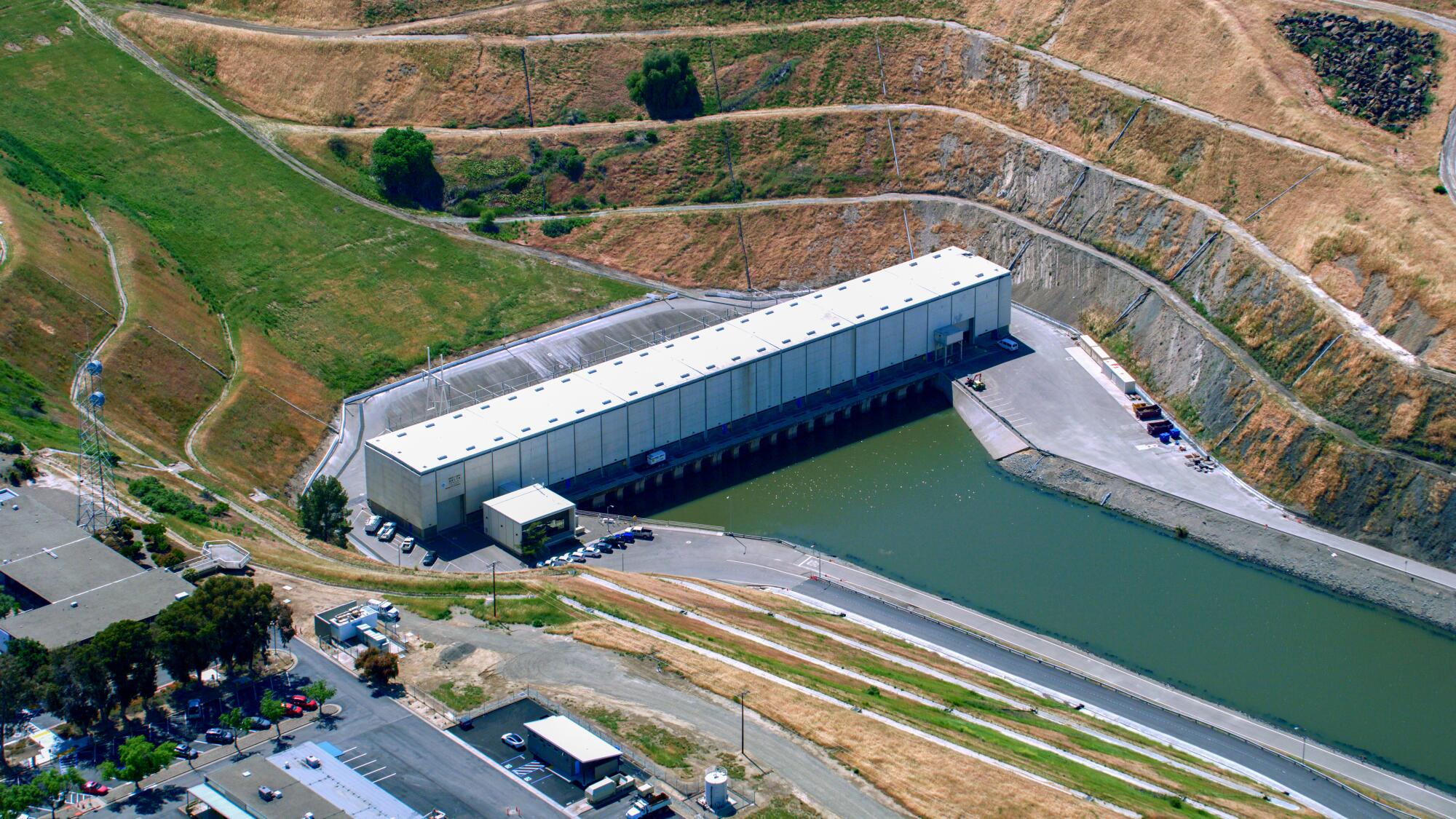
According to the California Department of Fish and Wildlife, estimated losses of steelhead trout exceeded the annual incidental take limit of 2,760 on March 20. By the end of March, the department said, the estimated losses of naturally spawned steelhead since Dec. 1 had risen to 3,374.
The estimated losses of endangered winter-run Chinook salmon also exceeded the annual loss threshold of 2,748 on March 20. Those estimated losses have since risen to 4,049, according to the Department of Fish and Wildlife.
State wildlife officials said the estimates are for fish that spawned naturally in rivers and don’t include losses of hatchery-raised fish.
(There is a caveat to the estimated losses of winter-run Chinook. State officials say they base their calculations on fish that are the size of winter-run Chinook rather than those that are genetically confirmed to be this type of salmon. As a result, officials say, some of the estimated losses are actually different types of salmon.)
The Department of Water Resources “is closely monitoring the collection system at the fish screens in front of the State Water Project pumps in the south delta,” said Karla Nemeth, the agency’s director.
“The majority of Chinook salmon and steelhead collected at the fish screens are collected alive and transported downstream of the pumps. We have been adjusting pumping operations to protect listed and endangered species,” Nemeth said in an email. “However, [State Water Project] operations have never been this restricted in a wet year as they are this year. These restrictions are keeping us from being able to capture and store the water that we need if we see a return to drought conditions.”
Environmentalists are calling for federal intervention after 4,000 threatened fish were killed by pumps operated by the State Water Project and the Central Valley Project.
The pumps that supply the State Water Project have been operating far below their capacity over the past three months. Agencies that receive supplies have been told to plan for 30% of their full allocations this year.
The permits and biological opinions that govern state and federal pumping operations include measures aimed at limiting the deaths of fish. In response to the losses, state and federal officials have been discussing measures being taken to protect fish.
Rosenfield said the water agencies aren’t doing nearly enough and argued that the losses put them in violation of permits.
“If you and I were out there killing hundreds and thousands of endangered fish, we’d be in jail,” Rosenfield said. “They’re not doing everything they can do to prevent the harm and mitigate the damage. There’s an opportunity to protect these fish by reducing water exports. It’s urgent ... and they’re doing nothing.”
The environmental and fishing groups — which include Defenders of Wildlife, the Bay Institute, Golden State Salmon Assn. and the California Sportfishing Protection Alliance — pointed to notes from a March 6 meeting at which officials from the National Marine Fisheries Service proposed reducing pumping to very low levels “as soon as possible, for a minimum of five days, and then reassessing.”
The groups said that despite this advice from fishery officials, the Department of Water Resources and federal Bureau of Reclamation “ignored these recommendations and continued to export water at rates that killed thousands of imperiled fishes.”
California officials analyzed options for new water rules in the Sacramento-San Joaquin Delta. Water suppliers and environmental groups are sharply divided.
Lenny Grimaldo, environmental director for the State Water Project, said in an interview with The Times that officials have kept pumping to levels they deemed were “protective of minimizing additional losses of fish but also protective of water supply.”
In an email, Grimaldo said that before the take limit for steelhead was reached on March 20, pumping at the State Water Project was reduced to protect the fish, and pumping remained at those low levels — around 1,200 cubic feet per second — through March 26 “to minimize further loss.”
Then, based on new information indicating that a higher level of pumping would “not draw any additional steelhead into the zone of the pumps,” Grimaldo said, the state consulted with federal officials and decided to “slightly increase exports” to 2,200 cubic feet per second on March 26.
The state and federal facilities were drawing in 2,400 cubic feet per second through Thursday, operating at a little over 20% of their combined capacity, Grimaldo said. After runoff from the latest storms boosted river flows, state officials on Friday said they were increasing water exports to 3,900 cubic feet per second, or 35% of full capacity, over the following five days.
Grimaldo said the Department of Water Resources “is continuing to comply with endangered species regulations, including ongoing consultation” with other state and federal agencies. The state agency is also investing in “rapid genetic technology” to better distinguish endangered winter-run salmon from other types, Grimaldo said, and to comply with requirements under law.
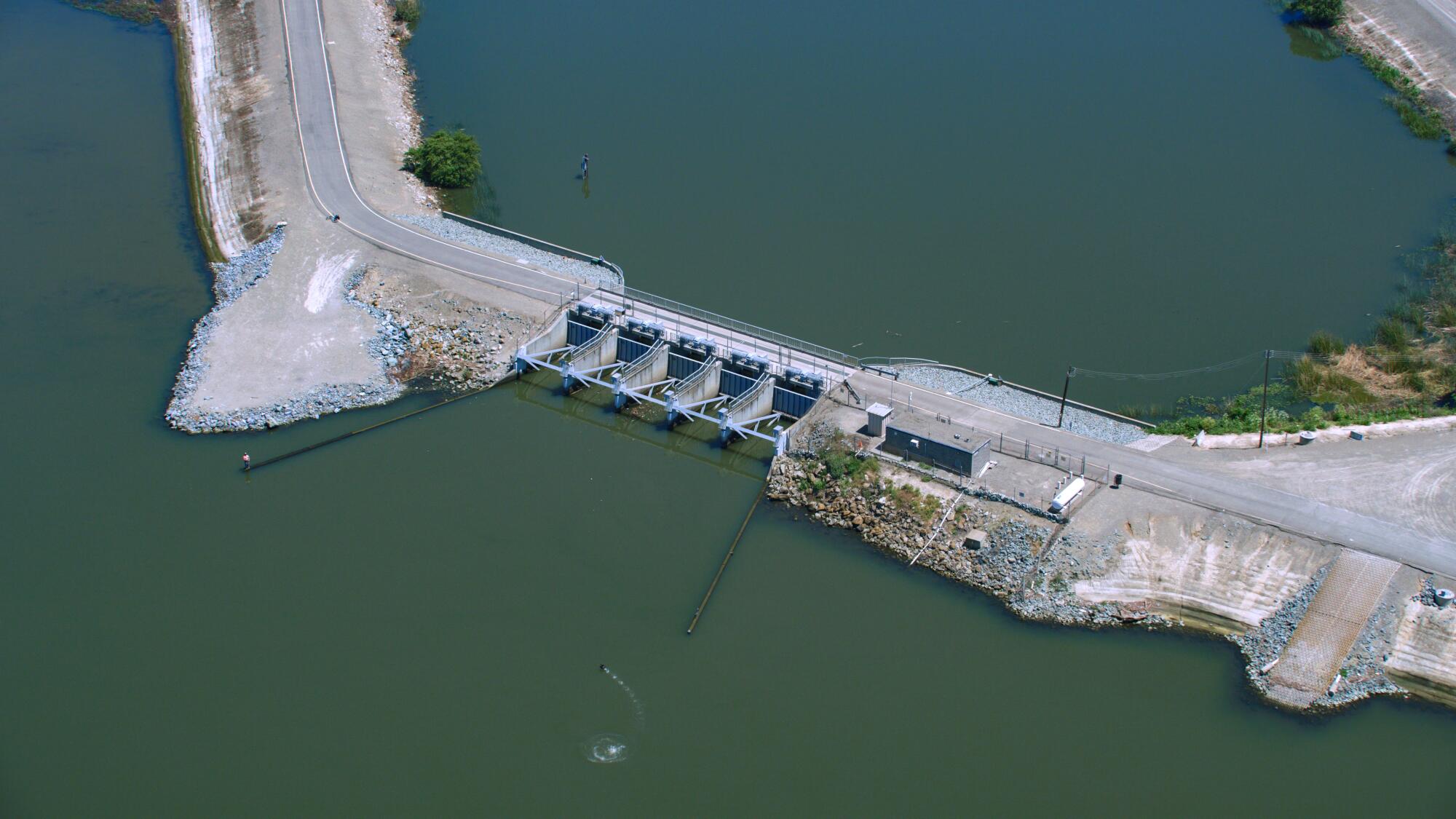
State officials said the agencies have formed a scientific review panel to study ways of improving operations.
“I’m concerned about this situation because I feel like these species are getting the short end of the stick,” said Ashley Overhouse, water policy adviser for Defenders of Wildlife.
She said that after one of the wettest winters on record, in 2023, and an above-average winter this year, it’s an optimal time for helping fish populations begin to recover from years of drought.
Other species that are at risk include threatened green sturgeon and endangered delta smelt. The population of threatened spring-run Chinook salmon has also suffered declines, and last year the fishing season for fall-run Chinook was canceled because of low population estimates.
“We have an estuary that’s the heart of our water management system and on the brink of collapse,” Overhouse said. “We are at a critical turning point, and any additional attention, coordination and, frankly, collective efforts and action that we can take to make sure that this doesn’t happen again is paramount.”
She said she hopes the outcry will spur discussion to protect fish populations.
“I think it’s possible. It’s just unfortunate that so many fish have to die in the process to get there,” Overhouse said.
California water regulators have eased requirements for urban water suppliers to meet conservation goals under proposed regulations.
The losses of fish coincide with other debates over how water should be managed in the delta. Regulators are considering alternatives for new standards and flow requirements that will determine how much water may be drawn from the delta.
Additionally, Gov. Gavin Newsom presented a plan last week outlining his administration’s priorities for changing how the state manages water to adapt to more extreme droughts and floods related to climate change. Newsom’s priorities include fast-tracking development of Sites Reservoir, the first new major reservoir in decades, and moving ahead with the proposed Delta Conveyance Project, a 45-mile tunnel that would transport water beneath the delta.
Nemeth said the restrictions on pumping have come at a cost to supplies. With a likely return of La Niña that could bring drier conditions, she said, “now is the time to capture and store this water while it’s available.”
“These conditions speak to the critical need to continue to advance the Delta Conveyance Project, which is an important part of how we can manage the impacts of climate change,” Nemeth said.
The Delta Conveyance Project is a key component of Gov. Gavin Newsom’s strategy for a hotter, drier California. Opponents say it will be an ecological disaster.
She said that in a wet year like this, the tunnel would allow the state to capture more water during high flows and store it for dry times, and “do so in a way that minimizes impacts to fish species.”
Rosenfield disagrees. He said state officials are wrongly assuming that tunnel fish screens would be more effective and argued that the tunnel would harm endangered fish and the delta’s ecosystem.
The rise in fish deaths is a symptom of a larger problem, Rosenfield said: California diverts too much water from the delta, to the detriment of its ecological health.
“From the fishes’ perspective, our unsustainable water diversions cause a nearly continuous, man-made drought — a drought so severe that numerous species that have thrived in the delta for eons are all declining toward extinction,” he said. “A delta tunnel will divert more water, not less.”

